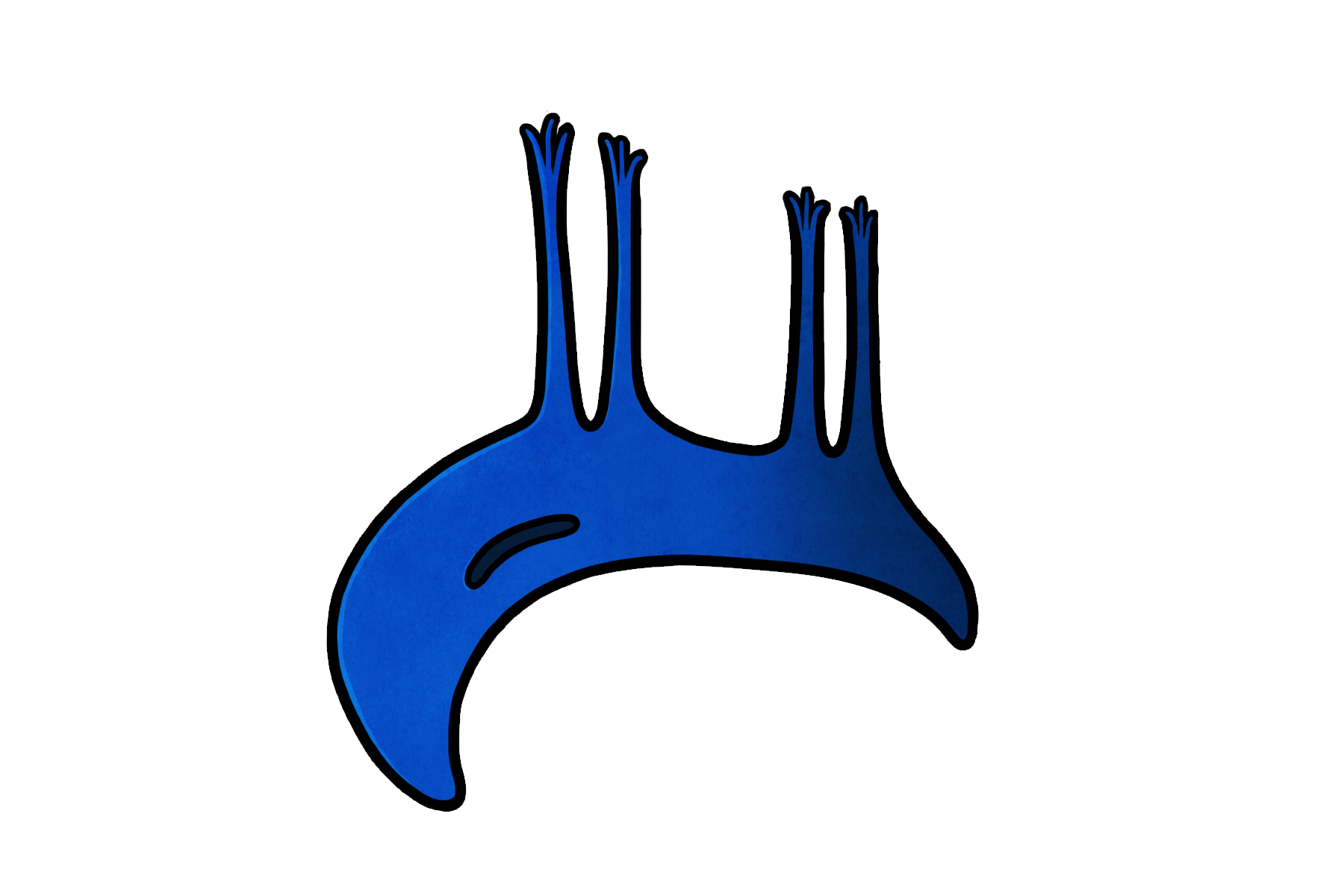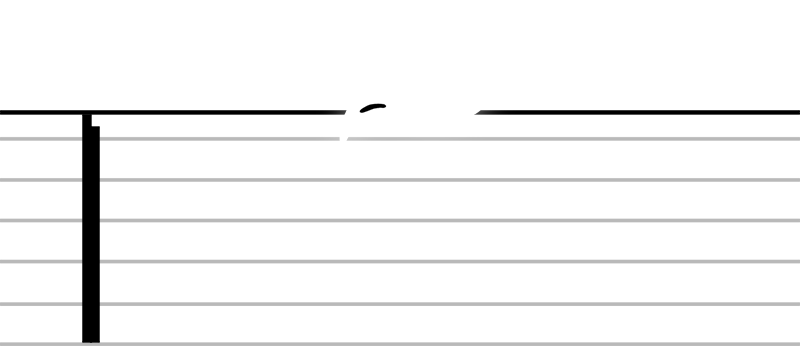

holodrue
the retinue
prefix holo suffix drue
holoforam du acep
physical appearance
The holodrue /ˈhɑlədɹuː/ is a solid blue stranger whose physical appearance is otherwise indistinguishable from its parent strain. Whereas the holodrone stands, however, the holodrue is inverted, its feet raised upward, and its nose remaining pointed towards the earth.
It floats up to five feet and six inches above the floor of any given area.
the electric sounds of the surrounding walls.

environment and generation
The holodrue generates within crowded spaces, such as subways stations or other hubs of transportation, blaring shopping malls, lively office buildings, oft-frequented parks, conference halls, and the occasional hotel.
It fades in with a loud and high-pitched click⼺ at its half-opaque point (this sound lasting less than a sixth of a second in duration).
⼺ Slowed down and observed, it sounded remarkably like a cassette tape, she insisted, even until the night before her execution.
When groups appear, they appear stacked directly behind the other at a equal distance of a half-inch.
isolation from other strains
Other strangers do not generate in the presence of a holodrue, and those strains with the fortune to be ambulatory make changes to their path to avoid entering into its territory. Groups of holodrue affect an area up to a quarter of a mile in diameter; this is exponentially greater than a single holodrue, which affects only enough space to cover a house.
attention to sensitives
As with the holodrone, the holodrue affixes itself to a sensitive, attaching itself at a distance of exactly seven feet.
For the most part, the holodrue can be passed through with no effect. Prolonged contact or proximity causes a wave of pins-and-needles that begins at the toes and works its way upward over a span of twelve hours, being more painful in unpredictable segments, though rarely causing excruciation.
A sensitive experiencing this will be able to transcribe the following message during sessions of heightened emotional fervor.
▟▝▞▞▖▗▜▙▞▝▚▞▝▙▘▞▞▞▞▘▙
▛▜▝▘▙▘▙▗▟▞▝▘▞▗▟▙▞▞▞▞▘▙
▞▚▚▙▚▞▝▟▙▞▞▞▘▞▖▝▚▙▝▗▘▖▞▛▗
▙▚▝▚▛▙▜▝▘▖▝▞▗▘▞▞▞▞▞▛▜▝▘
▙▘▙▗▟▞▝▘▞▗▟▙▟▝▞▜▙▘▞▞▞▞▞▞▞▚▚▙▝▗
▗▘▛▟▝▞▗▙▝▞▞▘▙▚▙▝▞▟▘▙▚▞▝▟▞▞▞▞▞▞▟▘▙▚▞▝▟▙▘▛▘▗▜▝▞▟▙▘▚▝▞▚▙▘▖
▞▟▘▙▚▞▝▟▙▘▛▘▗▜▝▞▟▙▘▚▝▞▚▙▘▖▗▘▛▟▝▞▗▙▝▞▞▘▙▚▙▝▞▟▘▙▚▞▝▟▞▞▞▞▞
▞▞▞▞▞▙▞▞▞▞▞▞▘▞▖▟▞▝▘▞▗▟▙▟▝▞▜▘▙▘▛▘▗▜▝▞▟▙▘▚▝▘▞
▚▙▘▖▗▘▞▗▙▝▞▞▘▙▚▝▜▞▘▚▖▟▞▝▚▟▜▝▘▖▝▞▗▘▞▞▞
▚▛▖▟▞▖▗▝▜▙▞▞▞▞▞▞▘▞▖▝▚▙▝▗▘▖▞▛▜▝▘▖▞▗
▙▚▝▚▛▙▜▝▘▖▞▞▞▘▞▖▝▚▙▝▗▘▖▞▛▗
▜▝▘▖▝▞▗▘▞▞▞▜▝▘▖▝▞▗▘▞▞▞▞▞▛▜▝▘
▗▟▞▝▘▞▗▟▙▟▝▞▜▙▘▞▞▞▞▞▞▞▚▚▙▝▗▜▝
▞▟▘▙▚▞▝▟▙▘▛▘▗▜▝▞▟▙▘▚▝▞▚▙▘▖
▘▛▟▝▞▗▙▝▞▞▘▙▚▙▝▞▟▘▙▚▞▝▟▞▞▞▞▞
▜▝▘▖▝▞▗▘▞▞▞▜▝▘▖▝▞▗▞▞▞▛▜▝▘
▙▘▙▗▟▞▝▘▞▗▟▙▟▝▞▜▝▞▚▙▘▖▗
▘▛▟▝▞▗▙▝▞▞▘▙▚▙▝▞▟▘▙▚▞▝▟▞▞▞▞▞
▞▞▞▞▞▙▞▞▞▞▞▘▞▖▝▚▙▝▗▘▖▞▛▗
▙▚▝▚▛▙▜▞▖▝▚▙▝▗▘▖▞▛▗
▙▚▝▚▛▙▜▘▞▞▞▞▞▛▜▝▘
▙▘▙▗▟▞▝▘▙▘▞▞▞▞▞▞▞▚▚▙▝▗
▞▟▘▛▘▗▜▝▞▟▙▘▚▝▞▚▙▘▖
▝▙▚▙▝▞▟▘▙▚▞▝▟▞▞▞▞▞
▘▞▗▟▙▟▝▞▜▘▙▞▞▞▞▛▜▝▘
▙▝▞▜▙▘▞▞▞▞▞▞▞▚▚▙▝▗
▞▟▗▜▝▞▟▙▘▚▝▞▚▙▘▖▗
▘▛▟▝▞▗▙▝▞▞▘▙▚▙▝▞
▞▞▘▞▖▝▚▙▝▗▘▖▞▛▗
▙▚▞▞▞▛▜▝▘
▞▜▙▘▞▞▞▞▞▚▚▙▝▗
▞▟▙▘▚▝▞▚▙▘▖▗
▘▛▟▝▞▗▙▝▞▞
▞▞▞▝▞▜▘▙
▟▝▞▜▙▘
▟▝▞
▟▝
▛
▛▜▝▘▙▘▙▗▟▞▝▘▞▗▟▙▞▞▞▞▘▙
▞▚▚▙▚▞▝▟▙▞▞▞▘▞▖▝▚▙▝▗▘▖▞▛▗
▙▚▝▚▛▙▜▝▘▖▝▞▗▘▞▞▞▞▞▛▜▝▘
▙▘▙▗▟▞▝▘▞▗▟▙▟▝▞▜▙▘▞▞▞▞▞▞▞▚▚▙▝▗
▗▘▛▟▝▞▗▙▝▞▞▘▙▚▙▝▞▟▘▙▚▞▝▟▞▞▞▞▞▞▟▘▙▚▞▝▟▙▘▛▘▗▜▝▞▟▙▘▚▝▞▚▙▘▖
▞▟▘▙▚▞▝▟▙▘▛▘▗▜▝▞▟▙▘▚▝▞▚▙▘▖▗▘▛▟▝▞▗▙▝▞▞▘▙▚▙▝▞▟▘▙▚▞▝▟▞▞▞▞▞
▞▞▞▞▞▙▞▞▞▞▞▞▘▞▖▟▞▝▘▞▗▟▙▟▝▞▜▘▙▘▛▘▗▜▝▞▟▙▘▚▝▘▞
▚▙▘▖▗▘▞▗▙▝▞▞▘▙▚▝▜▞▘▚▖▟▞▝▚▟▜▝▘▖▝▞▗▘▞▞▞
▚▛▖▟▞▖▗▝▜▙▞▞▞▞▞▞▘▞▖▝▚▙▝▗▘▖▞▛▜▝▘▖▞▗
▙▚▝▚▛▙▜▝▘▖▞▞▞▘▞▖▝▚▙▝▗▘▖▞▛▗
▜▝▘▖▝▞▗▘▞▞▞▜▝▘▖▝▞▗▘▞▞▞▞▞▛▜▝▘
▗▟▞▝▘▞▗▟▙▟▝▞▜▙▘▞▞▞▞▞▞▞▚▚▙▝▗▜▝
▞▟▘▙▚▞▝▟▙▘▛▘▗▜▝▞▟▙▘▚▝▞▚▙▘▖
▘▛▟▝▞▗▙▝▞▞▘▙▚▙▝▞▟▘▙▚▞▝▟▞▞▞▞▞
▜▝▘▖▝▞▗▘▞▞▞▜▝▘▖▝▞▗▞▞▞▛▜▝▘
▙▘▙▗▟▞▝▘▞▗▟▙▟▝▞▜▝▞▚▙▘▖▗
▘▛▟▝▞▗▙▝▞▞▘▙▚▙▝▞▟▘▙▚▞▝▟▞▞▞▞▞
▞▞▞▞▞▙▞▞▞▞▞▘▞▖▝▚▙▝▗▘▖▞▛▗
▙▚▝▚▛▙▜▞▖▝▚▙▝▗▘▖▞▛▗
▙▚▝▚▛▙▜▘▞▞▞▞▞▛▜▝▘
▙▘▙▗▟▞▝▘▙▘▞▞▞▞▞▞▞▚▚▙▝▗
▞▟▘▛▘▗▜▝▞▟▙▘▚▝▞▚▙▘▖
▝▙▚▙▝▞▟▘▙▚▞▝▟▞▞▞▞▞
▘▞▗▟▙▟▝▞▜▘▙▞▞▞▞▛▜▝▘
▙▝▞▜▙▘▞▞▞▞▞▞▞▚▚▙▝▗
▞▟▗▜▝▞▟▙▘▚▝▞▚▙▘▖▗
▘▛▟▝▞▗▙▝▞▞▘▙▚▙▝▞
▞▞▘▞▖▝▚▙▝▗▘▖▞▛▗
▙▚▞▞▞▛▜▝▘
▞▜▙▘▞▞▞▞▞▚▚▙▝▗
▞▟▙▘▚▝▞▚▙▘▖▗
▘▛▟▝▞▗▙▝▞▞
▞▞▞▝▞▜▘▙
▟▝▞▜▙▘
▟▝▞
▟▝
▛
aging and death
Instead of fading out, the holodrue flickers from existence. This flicker-out does not always signal its death, though, and it fades back into view several times, until at last, it does not.



